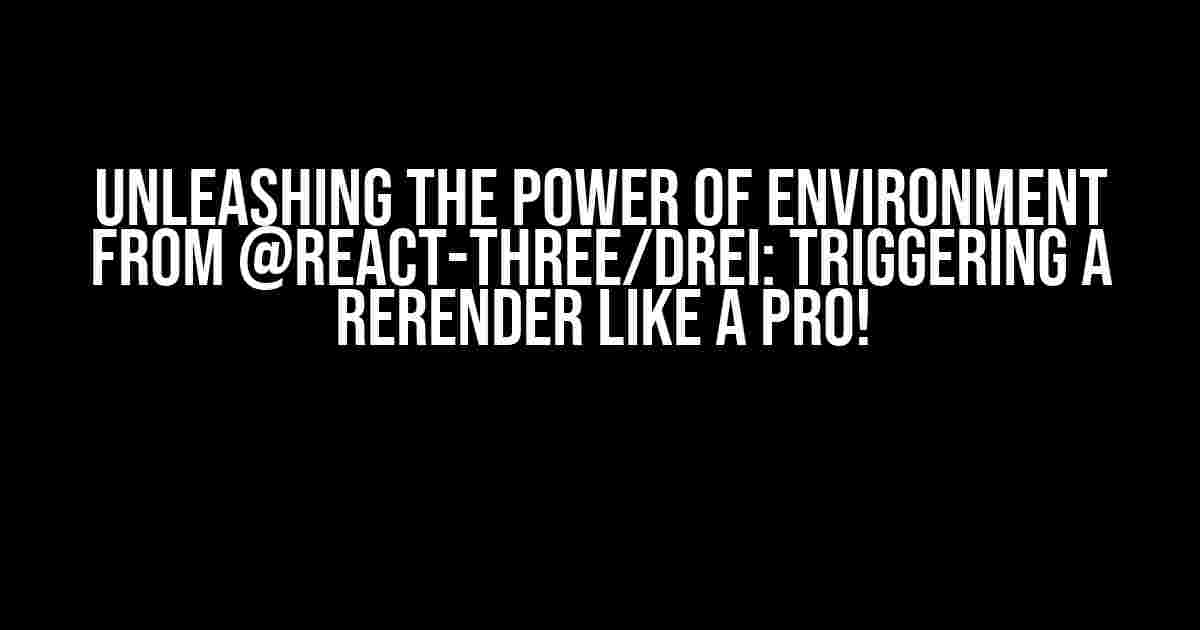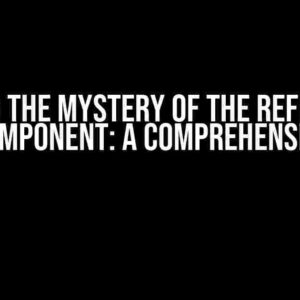Are you tired of struggling with environment-related issues in your React Three Fiber projects? Do you find yourself stuck in a loop of trial and error, wondering why your beautiful three-dimensional scenes refuse to update correctly? Fear not, dear developer! In this comprehensive guide, we’ll dive into the wonderful world of Environment from @react-three/drei, and show you how to trigger a rerender like a seasoned expert.
What is Environment from @react-three/drei?
For those unfamiliar, Environment is a powerful tool from the popular @react-three/drei library, designed to simplify the process of creating stunning, real-time 3D environments for your React applications. By leveraging the capabilities of Three.js, Environment allows you to craft breathtaking scenes, complete with realistic lighting, reflections, and animations, all within a React context.
The Problem: Triggering a Rerender
So, why do we need to trigger a rerender, you ask? Well, when working with dynamic scenes or loading new assets, your Environment might not automatically update to reflect the changes. This can lead to frustrating issues, such as:
- Outdated scene information
- Incorrect lighting or reflections
- Frozen or stuck animations
By triggering a rerender, you ensure that your Environment accurately reflects the current state of your scene, guaranteeing a seamless user experience.
Triggering a Rerender: The Basics
Now that we’ve covered the why, let’s dive into the how. There are several ways to trigger a rerender, but we’ll start with the most straightforward approach:
import { Environment, useFrame } from '@react-three/drei';
function MyScene() {
const { camera, gl } = useThree();
useFrame(() => {
// Trigger a rerender here
gl.render(camera, gl.scene);
});
return (
{/* Your scene content here */}
);
}
In this example, we use the `useFrame` hook from @react-three/fiber to execute a function on every frame. Within this function, we call `gl.render(camera, gl.scene)`, forcing a rerender of the scene.
When to Trigger a Rerender
Now that we’ve covered the basics, let’s explore when to trigger a rerender. There are several scenarios where triggering a rerender is essential:
-
After loading new assets:
useEffect(() => { gl.render(camera, gl.scene); }, [newAssetLoaded]); -
When the scene changes:
useEffect(() => { gl.render(camera, gl.scene); }, [sceneChanged]); -
On window resize:
window.addEventListener('resize', () => gl.render(camera, gl.scene));
These scenarios ensure that your Environment stays up-to-date and reflects the current state of your scene.
Advanced Rerender Techniques
Now that we’ve covered the basics, let’s dive into some advanced techniques for triggering a rerender:
Using a Custom Rerender Function
import { Environment, useThree } from '@react-three/drei';
function MyScene() {
const { camera, gl } = useThree();
const rerender = () => {
// Custom rerender logic here
gl.render(camera, gl.scene);
};
return (
{/* Your scene content here */}
);
}
In this example, we create a custom `rerender` function, which can be called manually by clicking a button. This approach allows for fine-grained control over when and how the rerender occurs.
Using a Rerender Interval
import { Environment, useThree } from '@react-three/drei';
function MyScene() {
const { camera, gl } = useThree();
useInterval(() => {
gl.render(camera, gl.scene);
}, 1000); // Rerender every second
return (
{/* Your scene content here */}
);
}
In this example, we use the `useInterval` hook from @react-three/fiber to trigger a rerender every second. This approach is useful for scenarios where you need to regularly update the scene, such as when simulating real-time data.
Rerender Optimization Techniques
As with any performance-critical application, optimizing rerenders is crucial to maintaining a smooth user experience. Here are some tips to help you optimize your rerenders:
| Techinque | Description |
|---|---|
| Use `requestAnimationFrame` | Instead of using `setInterval` or `setTimeout`, use `requestAnimationFrame` to schedule rerenders, ensuring synchronization with the browser’s animation frame. |
| Leverage `shouldComponentUpdate` | Implement the `shouldComponentUpdate` lifecycle method to determine whether a rerender is necessary, reducing unnecessary computations. |
| Utilize `useMemo` or `useCallback` | Use `useMemo` or `useCallback` to memoize computationally expensive functions or props, reducing the likelihood of unnecessary rerenders. |
By applying these optimization techniques, you can ensure that your Environment rerenders efficiently, without compromising performance.
Conclusion
In this comprehensive guide, we’ve explored the world of Environment from @react-three/drei, covering the basics of triggering a rerender, when to trigger a rerender, and advanced techniques for customizing and optimizing rerenders. By mastering these concepts, you’ll be well on your way to crafting breathtaking, dynamic 3D environments that leave users in awe.
Remember, with great power comes great responsibility. Use your newfound knowledge wisely, and always keep performance and optimization top of mind.
Happy coding, and see you in the next article!
Here are 5 questions and answers about “Environment from @react-three/drei triggering a rerender” in HTML format:
Frequently Asked Questions
Get the answers to your questions about Environment from @react-three/drei triggering a rerender!
Why does the Environment from @react-three/drei trigger a rerender?
The Environment from @react-three/drei can trigger a rerender because it uses the `useFrame` hook from `@react-three/fiber`, which causes the component to re-render on every frame. This is necessary to update the environment props and maintain the 3D scene.
Can I prevent the rerender triggered by the Environment?
Yes, you can prevent the rerender by using the `useMemo` hook to memoize the environment props. This will prevent the component from re-rendering unnecessarily. However, be careful not to memoize the props too aggressively, as this can lead to bugs and inconsistencies in the 3D scene.
What are the performance implications of the Environment triggering a rerender?
The performance implications of the Environment triggering a rerender can be significant, especially for complex 3D scenes. This is because the rerender causes the entire component tree to be re-evaluated, which can lead to increased CPU usage and slower frame rates. To mitigate this, use optimization techniques such as memoization, shouldComponentUpdate, and RENDER_OPTIONS.
How can I debug issues related to the Environment triggering a rerender?
To debug issues related to the Environment triggering a rerender, use the React DevTools to inspect the component tree and identify which components are re-rendering unnecessarily. You can also use the `useWhyDidYouRender` hook to gain insight into why a particular component is re-rendering. Additionally, check the console logs for any error messages or warnings related to the Environment.
Are there any alternative solutions to using the Environment from @react-three/drei?
Yes, there are alternative solutions to using the Environment from @react-three/drei. For example, you can use a custom implementation of the environment using THREE.js or other 3D libraries. However, keep in mind that these alternatives may require more manual setup and configuration, and may not provide the same level of convenience and simplicity as the Environment from @react-three/drei.


